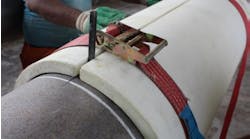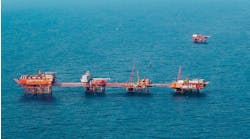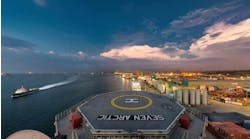Developing the ‘right’ concept for offshore developments
Selecting the “right” concept for producing an offshore field can have a major impact on the success of the project. In light of that fact, the conceptual phase needs to be scrutinized thoroughly. It ultimately becomes the stepping stone for the front end engineering design (FEED), detailed design, and execution phases that follow and allow a concept to become reality.
A project’s conceptual phase is, in itself, a series of phases that eventually lead to the best possible solution to fit the known project parameters. The process of developing a concept can be short or involved, depending on the nature and complexity of the project and the client’s requirements. It can be undertaken regardless of water depth or location, although as the specifics of those two facets intervene, viable options might be reduced. The conceptual phase is not just about numbers. There are many issues that need to be addressed yet can’t yield concrete information that can be strictly quantified. Rather, the concept process also deals with those “soft” issues such as government and regulatory mandates, company standards, and requirements or biases from past experiences that can play a major role in the decision-making.
This article addresses the multiple steps in the conceptual design process and suggests a logical, sequential method to initiate and complete this phase of the project. As a caveat, however, it is recognized that there are other approaches that might be taken to develop a viable concept. Further, there are complexities that might present unique considerations that can not all be addressed here. The recommendations contained in this article are based on successful projects and might provide some ideas to improve your concept development process.
The conceptual phase involves capturing relevant information, selecting the most appropriate concept team, communicating key drivers, obtaining alignment of purpose, identifying concepts to study, studying those options, and then selecting the best option(s) for the project. We will address each one of these steps and provide a rudimentary understanding of the factors that have the most impact.
Capture relevant information
Before an offshore project can be deemed viable, enough information must be known about the field, reservoir characteristics, existing infrastructure, and other data. At the concept phase, concrete information is not always available. There will undoubtedly be unknowns that will have to be surmised or accounted for later. The collection of relevant input is key to the success of the project. Where sufficient information is not available, experienced personnel can often make realistic assumptions that can guide the effort.
- Reservoir data, derived from exploratory and appraisal wells will give insights as to the size, pressures, temperatures, and other pertinent information. Immediate or future water injection or gas lift projections must be factored in
- Drilling requirements, including timing, number of wells, anticipated depth of wells, type of trees - dry or subsea, anticipated workovers, location of rig (on a central structure or MODU), and rig availability are all factors
- Operational considerations, such as expected uptime, flexibility needed and requirements for discharge or disposal need to be addressed. Anticipated flow assurance issues need to be considered
- Flowline information, including distances from subsea wellhead via umbilicals and risers, is relevant. Similarly, export planning must be considered to determine existing infrastructure, proximity to hubs and export line requirements for complying with transport regulations and delivery standards
- Location of the field is important in factoring in the impact of governmental and regulatory agencies. In US waters, responsibilities fall under the jurisdiction of the US Coast Guard, the MMS, and other governmental bodies. For non-US projects, the knowledge of national regulatory policies and possible taxation issues must be anticipated
- Consideration of client preferences, mandates, and specifications are critical to the concept selection. Specific safety issues, tolerances for risk, and corporate guidelines have to be understood and accounted for.
Concept team selection
There are multiple approaches to conducting conceptual engineering. It can be done in-house by the client’s project specialists. It can be performed by contractors, or by an integrated team of professionals. The key is to use the most experienced personnel available.
Because of project complexity, no one company has all the experts needed for selection, but needs to draw on an independent team. In the current state of the industry, it may be difficult to locate and engage the most knowledgeable team, but proper member selection can circumvent future cost overruns. Conceptual engineering performed by the lowest bidder is not always the best bargain, as proper conducting of this phase can make the biggest impact on the entire project’s cost and schedule.
Identifying contractors that have had experience with similar facilities or water depths can be important. They can provide the necessary historical databases and benchmarking from prior projects to validate results. It is also important to consider partners who have not only done conceptual planning, but who are knowledgeable in FEED, detail design, and project execution strategies to be able to provide viable and current cost estimates.
During the selection of the concept team, an awareness of potential preferences or biases should be considered and evaluated. Clients often install the same type of fixed or floating structure as past projects, even if reservoir conditions might suggest the use of other alternatives. Similarly, certain contractors can have a preference for a specific hull design that might, or might not, be the optimum. These biases can often provide the right solution for the field development, but it needs to be challenged. As a check, team members that are “solutions independent” might be considered. They can provide engineering with a sole focus on providing a fit-for-purpose concept.
Key driver communication
The client’s statement of requirements or preliminary design basis is important to incorporate in the concept phase, in order to evaluate, validate, and communicate key information to all participants. Additionally, the client’s project drivers, including its economic model of cash flow projections, safety, quality, schedule, and cost - need to be prioritized and provided to all stakeholders.
Early and complete alignment is critical. Participants need to be aligned on the project objectives and drivers as early in the process as possible. An initial meeting can assure that everyone is operating with proper knowledge and compatibility. On the other hand, misalignment of purpose and direction can cause confusion, frustration, and inefficiency, often leading to rework and cost escalation.
An example of alignment importance is a client’s requirement for the lowest possible topsides cost. Given this direction, the engineering contractor would generally eliminate all unnecessary equipment, reduce in-place spares, and minimize deck footprint to save weight. This might not be exactly what the client intends, especially if it means giving up flexibility and future capacity expansions. Alignment at the concept phase can avoid many of these misconceptions and information gaps.
Concepts for consideration
Based on a thorough understanding of the relevant information and project drivers, the right concept might be readily determined and quickly rise to the surface as the most logical. Even so, it is still a prudent exercise to enumerate the possible options that are available for consideration. Both existing and new technologies should be considered in this exercise. New technologies can be merely existing techniques extended to fit a new purpose, though they should be examined carefully as this is not the time for incurring research and development costs. The prioritizing of concepts should be based on high-level costs, schedule, execution plan, and risks, both technical and commercial. As previously mentioned, before finalizing on the concepts to be further studied, a review of potential biases in the selection process should be undertaken.
Determine optimum
Once the most viable concepts have been identified, they need further evaluation. There are multiple criteria upon which this process should be based. It must include capital and operating costs. It should also include schedule considerations - fast-track, phased-development, or a combination. Additional evaluations should focus on risks and the advantages or disadvantages of the selected concepts. There will be tradeoffs to virtually every alternative selected. These have to be weighed and prioritized. Benchmarking from prior projects helps in this phase of the concept selection process as does an independent review by peer groups.
At this point, there should usually be at most two concepts that have emerged from previous deliberation. These remaining alternatives should be further scrutinized by assuring that there is competition for their fabrication, transport, and installation. Without that capability, a project can get locked in to one method and not allow for flexibility or change in market conditions.
Wrapping up
Performing a good conceptual engineering study should yield an optimum result that is the best offshore project solution, fitting the client’s requirements. In order to complete this phase satisfactorily, the best available information needs to be accumulated and reviewed. The most experienced team should be assembled, equipped with benchmarking tools and a solid technical database from prior projects. It is critical that all stakeholders be aligned, with buy-in at the earliest possible stage, in order to provide focus and momentum going forward. All potential concepts need to be evaluated with the completed project in mind, keeping competitive options open for fabrication, transport, and installation. And, an independent approach needs to be taken, allowing biases to be considered as part of the process, but not overriding the process. If these steps are followed, the “right” concept should emerge, and chances for a successful fit-for-purpose project are greatly elevated.
Author
Daryl B. Rapp, P.E., P.M.P., has more than 30 years experience in the design and project management of oil and gas facilities. His projects have included multiple types of fixed and floating offshore facilities, as well as onshore plants. He has been the lead on numerous conceptual studies for offshore development projects and was recently project manager for four truss spar topside facilities in the Gulf of Mexico. Rapp is a graduate of Purdue University, a registered professional engineer in the state of Texas and a project management professional.





